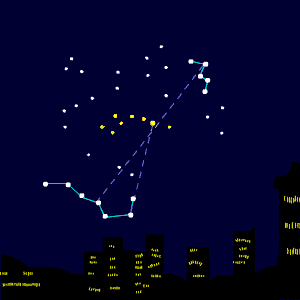Activity:Cassiopeia and Ursa Major
Appearance
Since Cassiopeia (constellation) and Ursa Major are w:circumpolar_star constellations they are an ideal first target to finding constellations and learning how the sky rotates.
Begin by finding a place with a good low Northern horizon and with minimal light pollution. Get a chart and a red light.
- find out whether Cassiopeia or Ursa Major is prominent. Generally:
- Cassiopeia is prominent in the fall
- Ursa Major is prominent in the spring
Both constellations have a compact distinctive shape. Cassiopeia looks like a W or a M. Ursa Major (aka the Big Dipper looks like a spoon, or a pot.
- Between the two constellations is the north star. People generally like to use the last two stars of the bowl, since it points right to it.
People also like to know where the Little Dipper is. In dark skies this is straightforward to do; you need to look for a dipper shape with the north star, defining the end of its handle.

